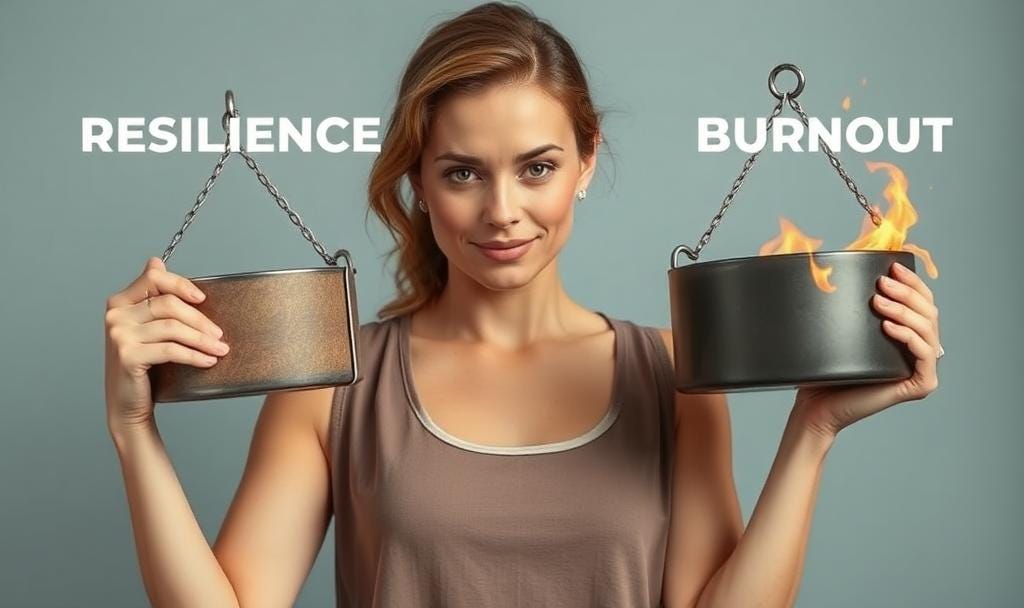Sonic Resilience: When Technology Meets Mental Health in the Era of Burnout
The fine line between perseverance and self-destruction lies in our ability to recognize when we need to rest
Imagine your brain as an immersive audio environment.
When you're truly resilient, it's like a beautifully balanced spatial audio mix.
Dynamic, responsive, with clarity across all frequencies.
But when you're merely persevering through burnout?
It's like destructive audio clipping.
Distorted, compressed, and gradually destroying the very system designed to process it.
This isn't just a metaphor.
The emerging science at the intersection of sound, technology, and mental health is revealing profound insights about how our brains process stress, and how we might harness the right auditory inputs to build genuine resilience rather than merely enduring burnout.
The Resilience Mirage: What Science Tells Us
Resilience isn't what most people think it is.
It's not about endurance or toughness.
The neurological signature of true resilience looks remarkably different from perseverance through burnout:
Resilient brains maintain strong connections between the prefrontal cortex (executive function) and limbic system (emotional regulation).
Burnout brains show hyperactivation of the amygdala with diminished activity in areas responsible for executive function.
What's fascinating is how quickly we can shift from one state to another.
Research from Stanford's Center for Compassion and Altruism Research shows that even brief interventions, including sound-based ones, can dramatically alter these neural pathways within days, not years.
The Sonic Dimension: How Audio Technology Is Revolutionizing Resilience
One of the most promising frontiers in mental health technology involves the strategic use of sound to build genuine resilience.
This isn't about simply playing relaxing music, it's about leveraging cutting-edge audio technology to create neurologically optimized sonic environments.
Adaptive Audio Environments
Forward-thinking companies are implementing adaptive audio systems that shift throughout the workday.
These systems use AI algorithms to detect stress patterns in employees (through subtle voice analysis or even typing patterns) and adjust ambient soundscapes accordingly.
The most sophisticated versions pair with biofeedback wearables to create a closed-loop system that continuously optimizes the sonic environment based on physiological markers of stress or recovery.
VR-Based Recovery Spaces
Virtual reality is emerging as a powerful platform for resilience-building through multisensory interventions.
Companies are creating immersive recovery environments that combine precisely calibrated spatial audio with visual and even haptic elements to trigger rapid parasympathetic activation.
The neurological impact is profound: just 10 minutes in these environments can reduce cortisol levels comparable to 45 minutes of traditional meditation, making them ideal "resilience boosters" for high-pressure workplaces.
Personalized Functional Music
Unlike generic relaxation tracks, these systems analyze your unique stress response patterns and generate custom compositions designed to counterbalance specific neural signatures of burnout.
The technology works by combining machine learning models with established music therapy principles to create personalized soundscapes that effectively "retune" dysregulated stress response systems.
Five Markers of True Resilience vs. Burnout
How can you tell if you're genuinely resilient or simply persevering through burnout? Look for these five key markers:
1. Recovery Capacity
Resilient individuals can quickly return to baseline after stress.
Those in burnout require increasingly longer recovery periods, if they recover at all.
The Technology Response: Biofeedback-driven audio interventions are being designed specifically to accelerate recovery capacity, using sound frequencies that trigger parasympathetic activation.
2. Emotional Granularity
Resilient people maintain nuanced emotional awareness.
Those in burnout experience emotional flattening, everything feels like generalized overwhelm.
The Technology Response: AI-driven emotional intelligence platforms now incorporate sound therapy modules that help rebuild emotional granularity through targeted acoustic stimulation.
3. Boundary Intelligence
Resilient professionals maintain clear boundaries.
Those in burnout experience boundary erosion, they're constantly available and chronically overextended.
The Technology Response: Smart audio environments that create "sonic boundaries" in open workspaces, using directional sound and noise-cancellation to establish psychological safety zones.
4. Adaptive Response Patterns
Genuine resilience manifests as flexibility.
Burnout leads to rigid persistence, applying the same ineffective strategies with increasing intensity.
The Technology Response: VR training programs with adaptive audio components that help users practice cognitive flexibility in response to simulated stressors.
5. Social Connection Quality
Resilient individuals maintain deep social connections.
Those in burnout experience social withdrawal and deteriorating relationship quality.
The Technology Response: Spatial audio technologies in virtual social spaces that preserve the neurological benefits of in-person connection, maintaining the subtle audio cues crucial for emotional resonance.
Building True Resilience: A Practical Framework
If you've recognized signs of burnout masquerading as resilience, here's a framework integrating cutting-edge audio technology with practical steps:
1. Implement Strategic Recovery
Schedule non-negotiable recovery blocks throughout your week.
Even brief periods (20-30 minutes) of genuine downtime with the right sonic environment can significantly reset your nervous system.
Technology Integration: Use apps like Endel or Brain.fm that generate personalized soundscapes designed specifically for cognitive recovery, not just relaxation.
2. Audit Your Sound Environment
Most people pay remarkably little attention to what enters their ears throughout the day.
Yet our auditory input significantly influences our neurological state.
Technology Integration: Implement noise-canceling technology strategically, and create custom sound environments for different cognitive tasks using specialized audio apps.
3. Cultivate Sensory Intelligence
Become more deliberate about your sensory inputs, particularly sound.
Even simple interventions can dramatically shift your neurological state.
Technology Integration: Experiment with functional music that utilizes specific frequencies (like 40 Hz for cognitive function or theta waves for recovery) during different parts of your day.
4. Prioritize Connection Over Performance
Schedule relationship time with the same commitment you give to work.
The neurochemical benefits of authentic connection provide powerful resilience buffers.
Technology Integration: When in-person connection isn't possible, opt for audio-rich virtual platforms that preserve spatial audio cues rather than text-based communication.
5. Embrace Adaptive Renewal
Rather than viewing resilience as endless endurance, reframe it as adaptive renewal, or the capacity to strategically oscillate between engagement and recovery.
Technology Integration: Use wearable devices that track stress markers and integrate with sound-based interventions to create personalized resilience-building systems.
The Future of Resilience Technology
As we look toward the horizon, these emerging technologies promise to revolutionize how we build and maintain resilience:
AI-Powered Burnout Detection: Machine learning algorithms that detect subtle linguistic and behavioral changes signaling impending burnout before conscious awareness, integrated with sound-based interventions
Immersive Recovery Environments: VR/AR experiences designed specifically to accelerate nervous system regulation through precisely calibrated spatial audio
Adaptive Work Interfaces: Productivity tools that adjust their functionality and audio environment based on your cognitive state
Neuroplasticity-Enhancing Audio: Targeted sound therapies that strengthen neural pathways associated with resilience and adaptive coping
The most exciting aspect of these innovations is their accessibility.
Many are already available or emerging in consumer-friendly forms, democratizing resilience tools that were once available only to elite performers.
The Choice Before Us
The distinction between true resilience and persevering through burnout isn't academic, it's the difference between sustainable success and eventual collapse.
As our world grows increasingly complex and demanding, the professionals, companies, and communities that thrive won't be those who can endure the most suffering, but those who master the art of strategic renewal through intentional practices including sophisticated use of sound and audio technology.
The question isn't whether you can keep pushing through.
It's whether you're building the capacity to thrive amid challenge through practices that strengthen rather than deplete you.
What will you choose, true resilience or the resilience mirage?
Best wishes,
Billy
Disclaimer: This newsletter is for informational purposes only and not professional advice. Individual results may vary. Use these practices at your own risk. Consult licensed professionals for medical, psychological, or serious issues. I am not liable for any damages arising from your use of this information.





